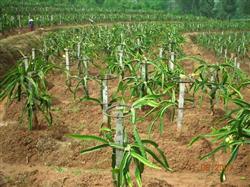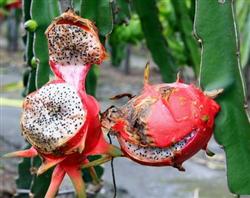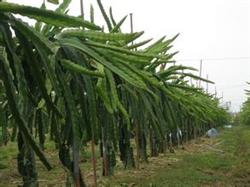How to cultivate Dragon Fruit in North China

Fire dragon fruit, also known as cactus honey fruit, red dragon fruit, is a kind of perennial climbing fleshy fruit. The dragon fruit originated from the American tropical rain forest and was later introduced into China. The cultivation of dragon fruit in greenhouse made the dragon fruit "planted in the south and north" successful. In this paper, the key technical points of cuttage propagation, growth and development stage management, greenhouse cultivation management and timely harvest of pitaya in greenhouse are introduced as follows: first, pitaya is mainly propagated by cutting or grafting. 1. Cuttage seedling raising: spring is the most suitable. Cuttings are selected from fully grown stem nodes, cut into small segments 15 cm long, and inserted into a sand bed after the wound is air-dried. It can take root in about 15-30 days, and when the root grows to 3-4 cm, it can be transplanted into the seedbed. two。 Grafting seedling: choose the rootstock with no disease and insect pests, strong growth and full stem and flesh as rootstock, and grafting in sunny day. Cut the stem of dragon fruit into plane with a knife, insert the scion, aim at the cambium, and fasten it with cotton thread. Under 28-30 ℃, a large number of calli were formed on the wound joint surface in 4-5 days. When the color of scion is close to that of rootstock, it shows that the vascular bundles of scion and rootstock have healed and grafted successfully, and then they can be moved into the pseudo-planting bed to continue to cultivate. 3. Seedling management: the nursery bed should choose fields with ventilation and sunny, fertile soil and convenient drainage and irrigation, and make the border with a width of 90 cm. 667 square meters (1 mu) first apply 1500 to 2000 kilograms of rotten chicken manure or cow manure, mixed with 100 kilograms of husk ash, mix well, apply to the topsoil layer 10 to 20 centimeters below the border during soil preparation, and then apply 100 kilograms to 150 kilograms of calcium magnesium phosphate fertilizer, stir fully with a hoe, and apply to the topsoil layer 4 centimeters deep. Finally, the seedlings were planted in the nursery bed according to the plant spacing of 3 cm, watered thoroughly, and sprayed with 500 times carbendazim solution once, and 5-7 kg compound fertilizer was applied every 10-15 days, and the full stem segments of the first stem could be grown out of the nursery. Second, cultivation and management of dragon fruit is a tropical plant, like light, shade, heat, drought, fertilizer, barren, its stem can also grow on the rock, the plant is very resistant to wind, as long as the bracket is strong enough to resist typhoon. Generally 667 square meters plant 300 square meters 400 plants, every 4 plants buried in the middle of a 20 cm square, 2 meters high cement column as a support. Pitaya can adapt to all kinds of soil, but it is better to use neutral soil with more humus, water and fertilizer conservation and weak acid soil. In order to make it grow vigorously after planting, more organic fertilizers such as fermented human, animal and poultry manure must be applied, and calcium magnesium phosphate fertilizer and compound fertilizer should be applied at seedling stage, and the amount should be determined according to plant size. The dragon fruit grows rapidly in a warm, moist, well-lit environment. Open field cultivation in spring and summer should be watered more, so that its roots to maintain a state of vigorous growth, in the rainy weather should be timely drainage, so as not to be infected with bacteria causing stem and flesh rot. The dragon fruit can withstand the low temperature of 0 ℃ and the high temperature of 40 ℃. In order to ensure its perennial growth and multiple fruit, the greenhouse temperature should reach 20-30 ℃ as far as possible. A greenhouse must be built to grow dragon fruit in the north, and the night temperature in winter should not be lower than 8 ℃. The plastic film can not be removed in summer, but it must be ventilated. The fire dragon orchard does not need to be ploughed, and the weeds can be cut off in time. The dragon fruit has a thick waxy layer and smooth appearance, which can be bagged-free, labor-saving and time-saving. The dragon fruit generally has no insect pests, occasionally there are nematodes in the roots and red spiders in the stems and leaves, so you can prevent and cure them in time. The dragon fruit takes about 32 days from flowering to fruit ripening. When the fruit changes from green to red and the fruit is slightly fragrant and bright, it can be harvested. Click to see more dragon fruit planting techniques
- Prev

How to fertilize dragon fruit scientifically
1. 20ppm cytokinin and 1000-fold farmer calcium were sprayed every 10-15 days during flowering. Cytokinin is used to promote the proliferation of fruit embryo cells in order to accommodate substances in the future expansion period and create a larger potential space. Calcium element is combined with pectin to form pectin calcium to improve the toughness of pericarp.
- Next

How to fertilize dragon fruit?
Soil fertilization is the main way of fertilization in orchards, and its methods are as follows: (1) Circular fertilization is also called wheel fertilization. It is to dig a circular ditch to fertilize a little farther away from the crown. This method has the advantages of simple operation and economical use of fertilizer. However, digging ditches is easy to cut off horizontal roots, and the range of fertilization is small, so it is generally used for fertilization of young trees. ...
Related
- Moge, come on! The staff of the peasant association in the producing area of cantaloupe were frightened when the crowd gathered.
- Causes and Solutions of low Fruit setting rate of Apple
- Symptoms and control measures of passion fruit virus disease
- Fruit growing lesson: how do apple orchards keep high yields?
- Can you build orchards in the mountains? What are the pros and cons?
- How to manage the coloring period of Crisson grape?
- This paper introduces the processing technology of two kinds of fig products.
- How much is a month for retired teachers in rural areas by 2020?
- How can strawberry planting increase sugar content? We should pay attention to management in many aspects.
- What are the cultivation techniques on how to improve the yield of golden fruit?

